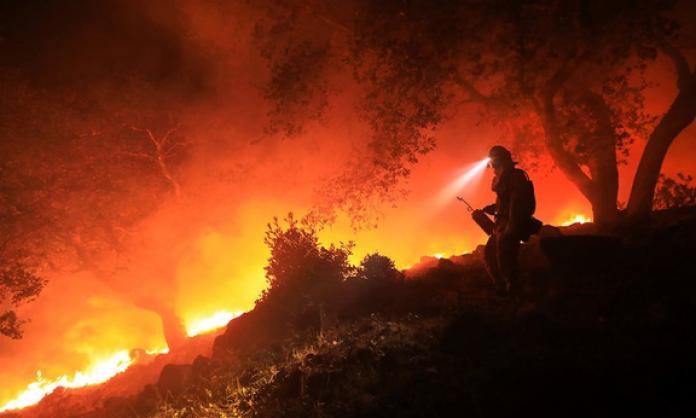Wildfires north of San Francisco, in California’s wine country, exploded in early October, fanned by hot and dry winds. They have wreaked unprecedented damage.
A week and a half later, the fires still burn. At least 41 people have been killed. While the fires started in hilly wooded areas, they moved into towns and cities, laying waste to more than 5,700 homes and other structures and burning through 213,000 acres (86,000 ha), making these the most damaging fire storms in California since records were first kept.
More than 100,000 people were evacuated, and many are still displaced.
Fire storms occur when smaller separate fires merge into a single large fire. At times, the fires spread so quickly that firefighters had to flee as fast as they could. Many of the deaths happened when people were unable to evacuate in time.
For many days, toxic smoke extended 160 kilometres south to San Francisco and beyond. Where I live, south-east of the city, the smell was so strong on one occasion that I thought my house was burning.
Household chemicals and other materials produce highly toxic ashes when burned. People returning to see if anything can be salvaged in the debris are in danger of poisoning. Karen Relucio, chief medical officer in Napa County, one of the hardest hit areas, said in an interview, “Just think of all the hazardous materials in your house, the chemicals, pesticides, propane, gasoline, plastic and paint. It concentrates in the ash, and it’s toxic”.
She warned people away from the ashes and declared a public emergency in the county, as have other burned-out areas. Long after the fires are extinguished, there will have to be a major effort to clean up all the dangerous toxic ash.
In the preceding five years, there was a once-in-500 year drought in California, which scientists linked to increased temperatures resulting from climate change. During this drought, more than 100 million trees died, providing a huge amount of fuel for this year’s fires.
California has a Mediterranean climate – wet winters and dry springs and autumns. During the five-year drought, the wet seasons were unusually short and not particularly wet, while the dry seasons were unusually long and hot.
Last winter, there were greater than average rains and snows, seeming to break the drought. The result was a high amount of regrowth in the spring. But once the rains stopped, California was gripped by a record-breaking season of high temperatures that dried out all this new growth.
San Francisco’s summers are usually cool and foggy. (Mark Twain once quipped that the coldest winter he ever experienced was summer in San Francisco.) But this year, temperatures reached 41 degrees Celsius, the highest ever recorded in the city.
“We are still impacted by five years of drought”, said California fire chief Ken Pimlott. “With the significant rain that we had last winter … we are literally looking at explosive vegetation. These fires are burning actively during the day and night, when one would expect a fire to subside. And make no mistake: this is a serious, critical, catastrophic event”.
An editorial in the Los Angeles Times noted:
“We don’t yet know what started the fires … but we have a good idea of what made them so destructive. This is not just bad luck. Coming on the heels of other large-scale natural disasters – Houston inundated by a slow-moving tropical storm, swaths of Florida and the Caribbean ripped to shreds by a monster hurricane, much of Puerto Rico levelled by an equally powerful hurricane, a handful of Western states swept by massive fires that burned up millions of acres – one can’t help but see a disturbing pattern emerge. Those superstorms that scientists warned would result from climate change? They are here. The day of reckoning isn’t in the future. It is now.”
The words “record breaking” have become commonplace: There have been a record 18 tropical storms this year in the Atlantic originating off the coast of Africa. Ten of these have become hurricanes – another record. And some are the strongest ever seen, as the Times noted. The remnants of one made it all the way to Ireland. Daniel Swain, climate scientist at the University of California in Los Angeles, said:
“The changes in climate that we’re experiencing are largely due to the human emission of greenhouse gases. And we expect warming to continue for as long as we continue to emit those greenhouse gases … If we choose to reduce and eventually eliminate our greenhouse gas emissions, we will avert much of the warming, much of the increased risk of extreme events like wildfires.”
Yet the world is moving in the opposite direction, with the burning of fossil fuels increasing. The present administration in Washington is populated by climate change deniers, hell bent on sourcing, selling and burning ever more coal, oil and natural gas.










